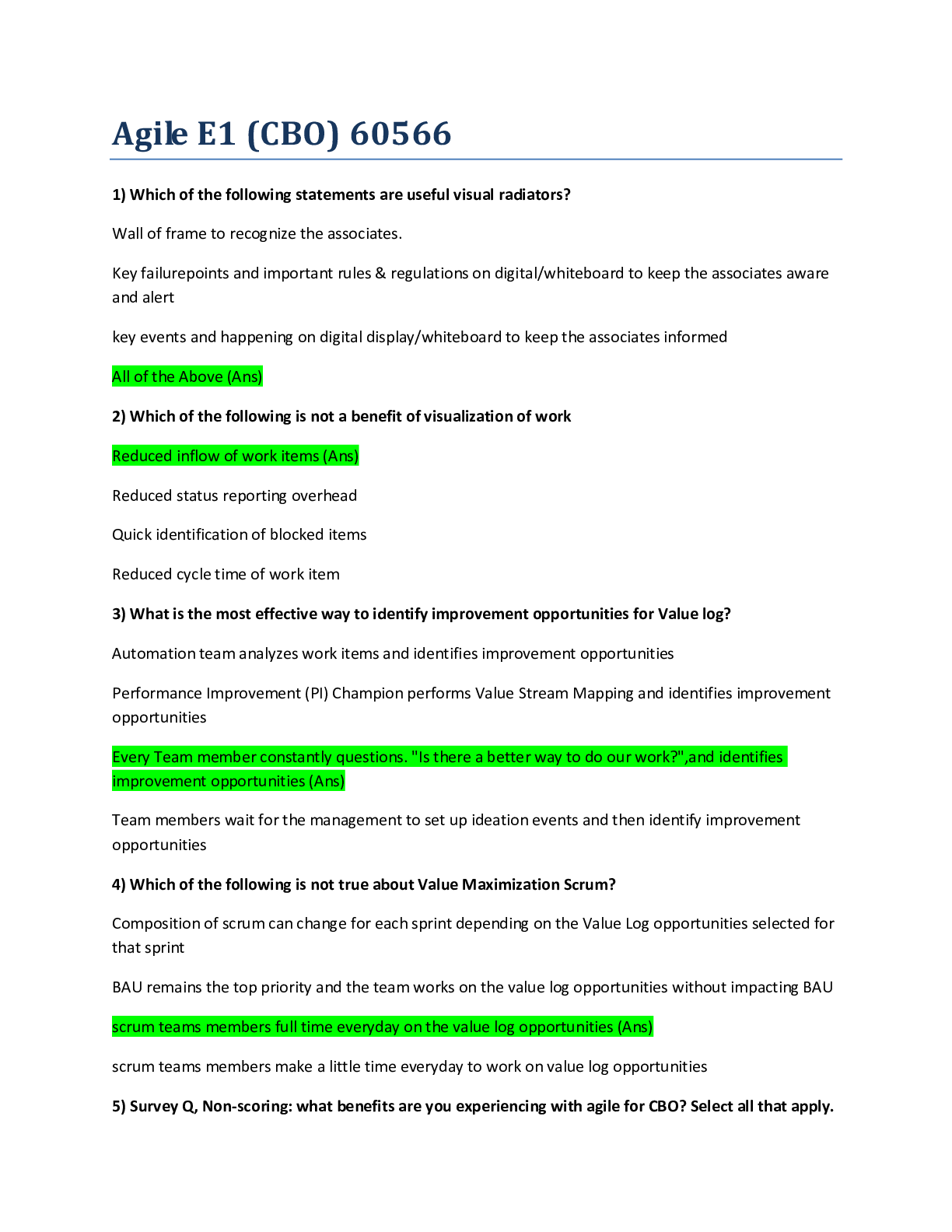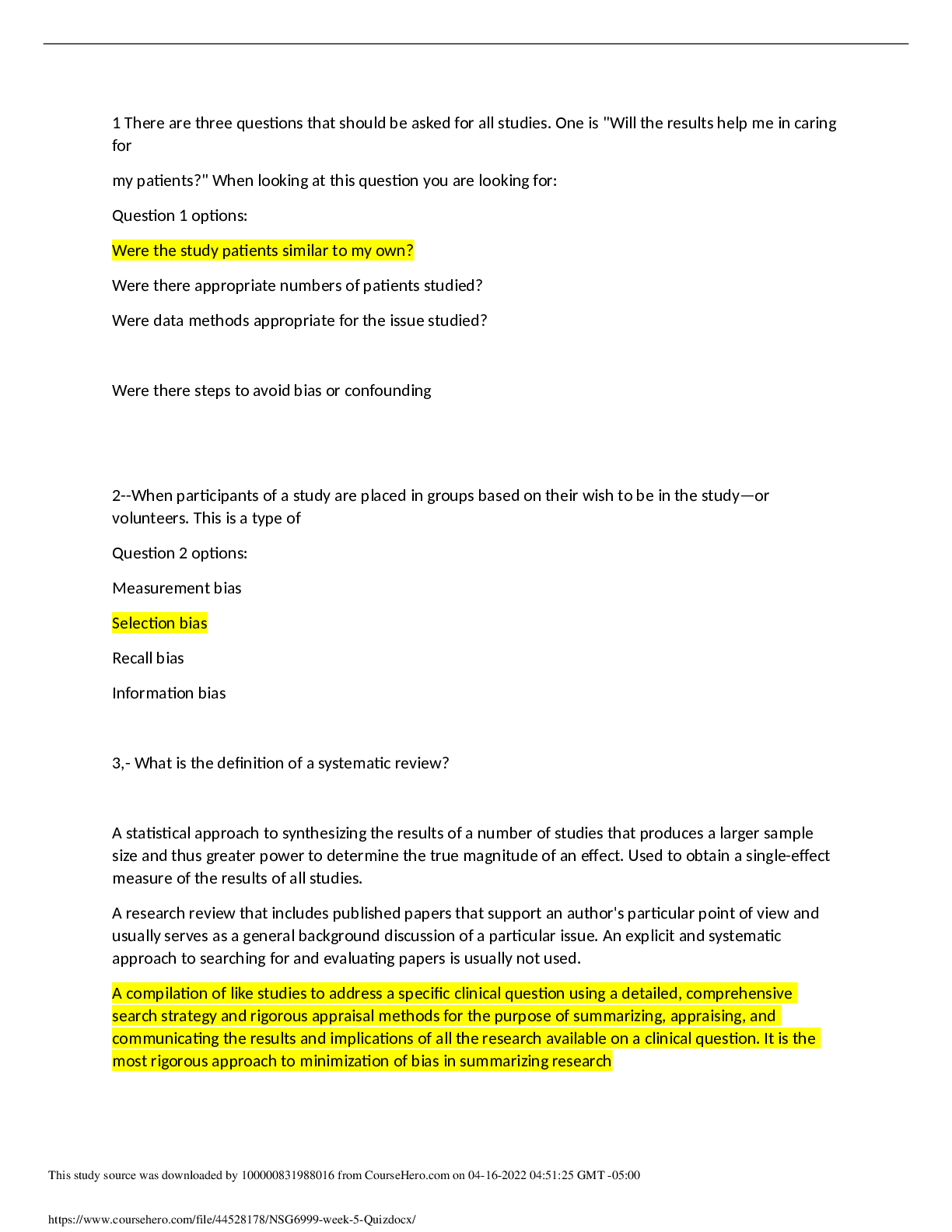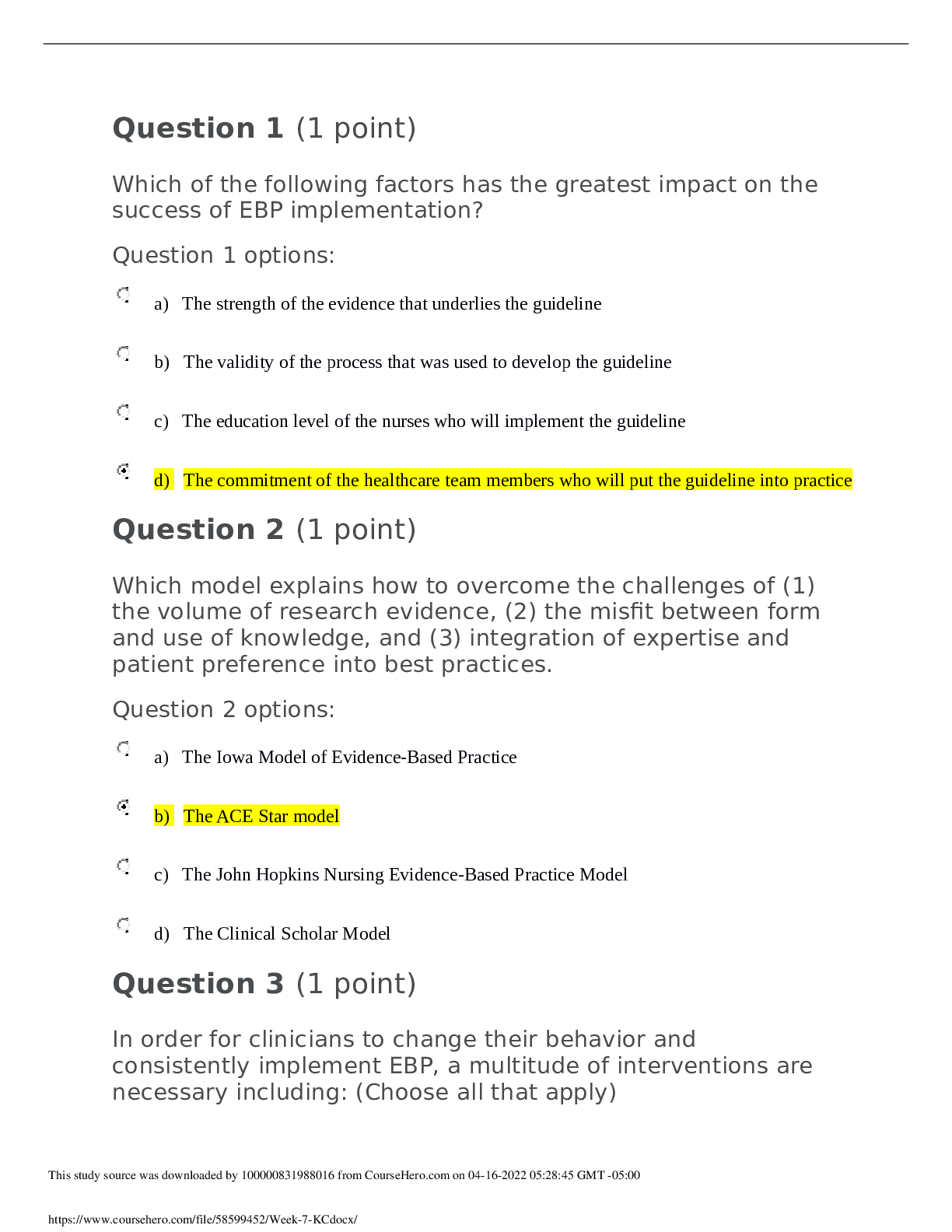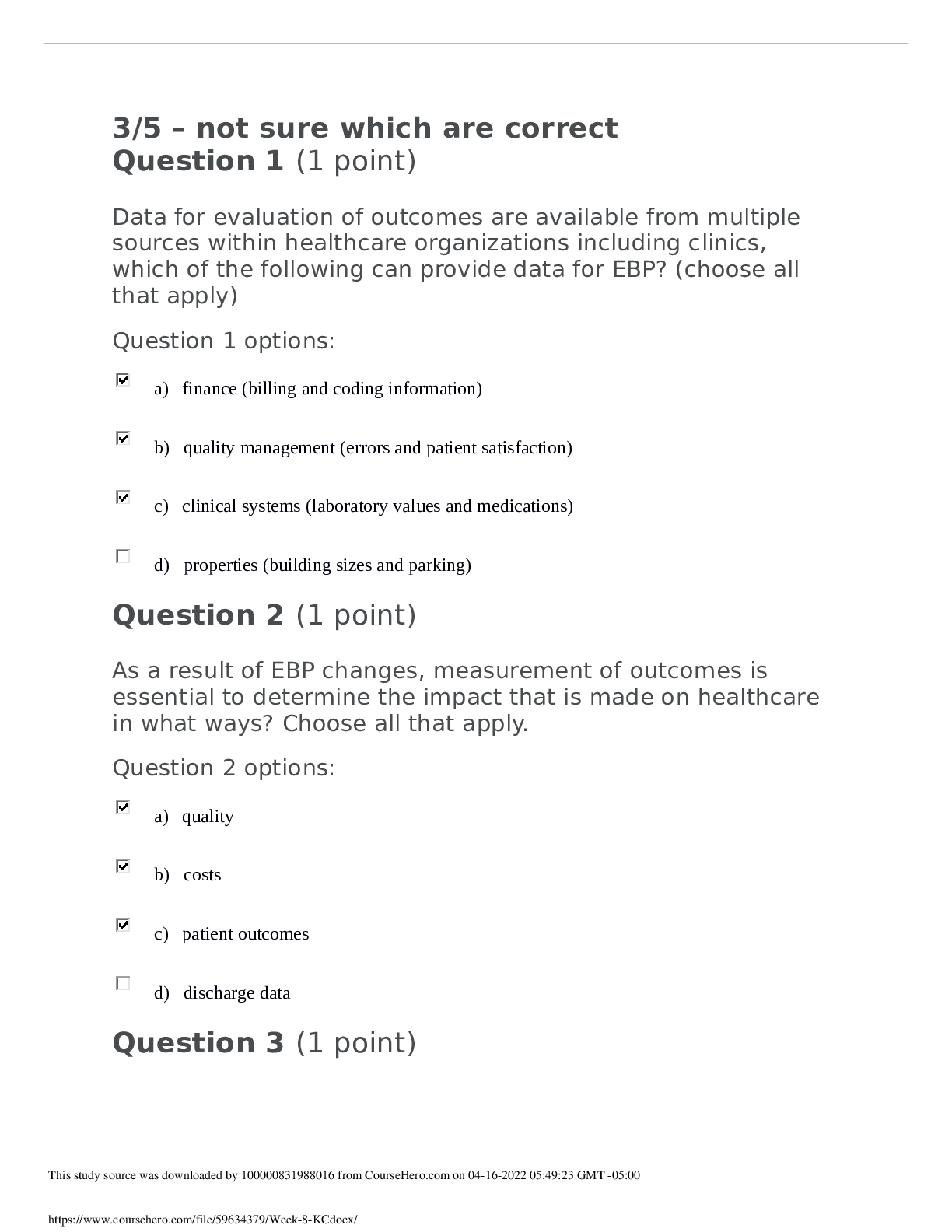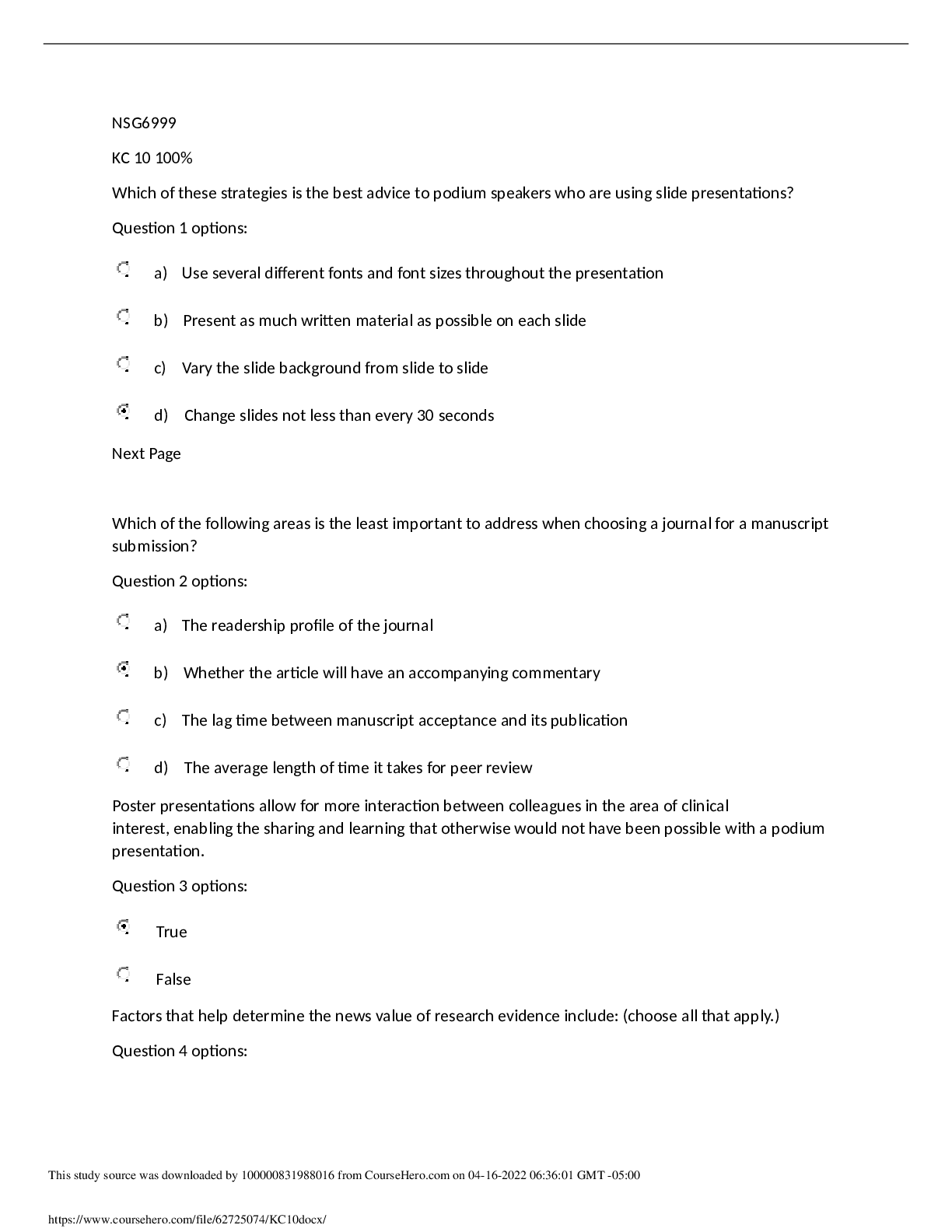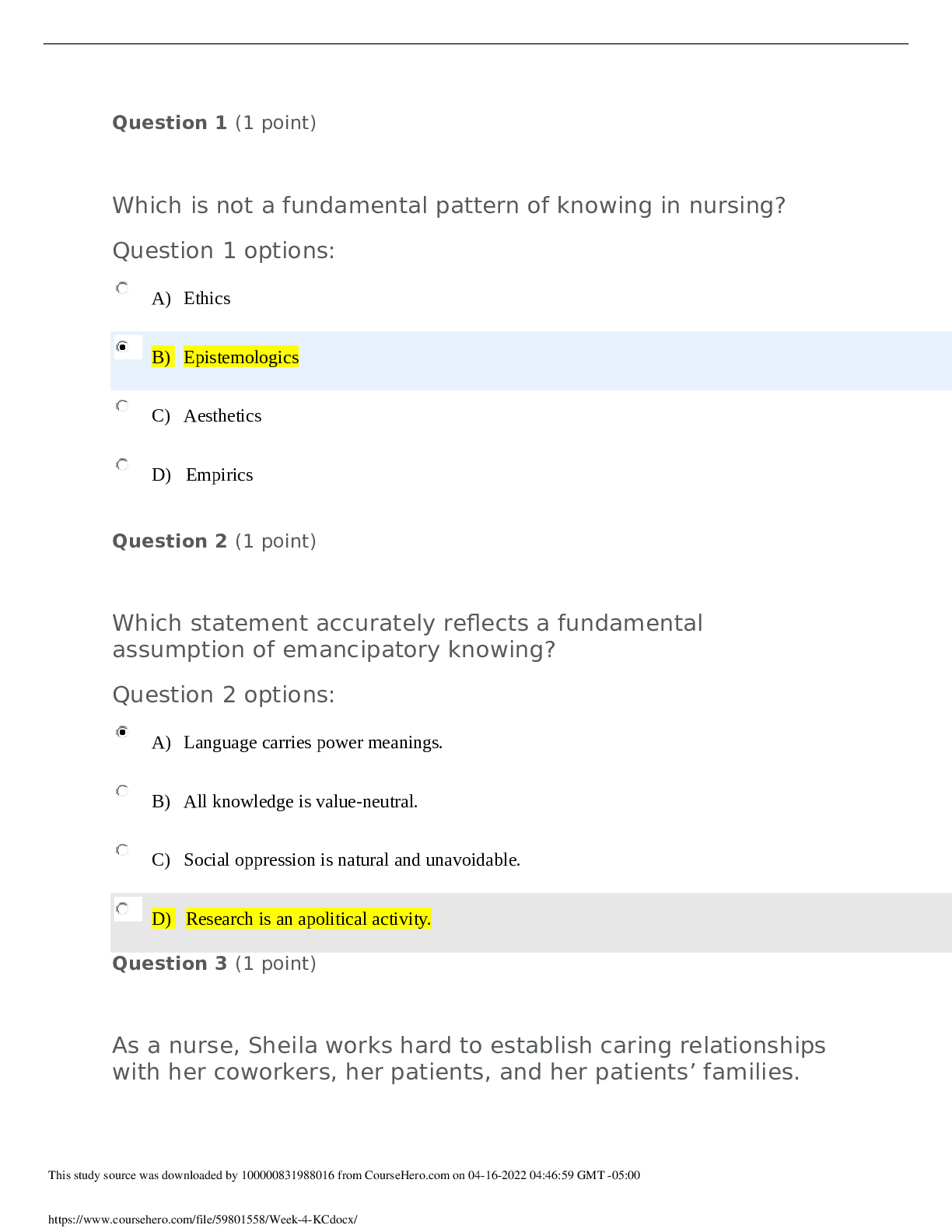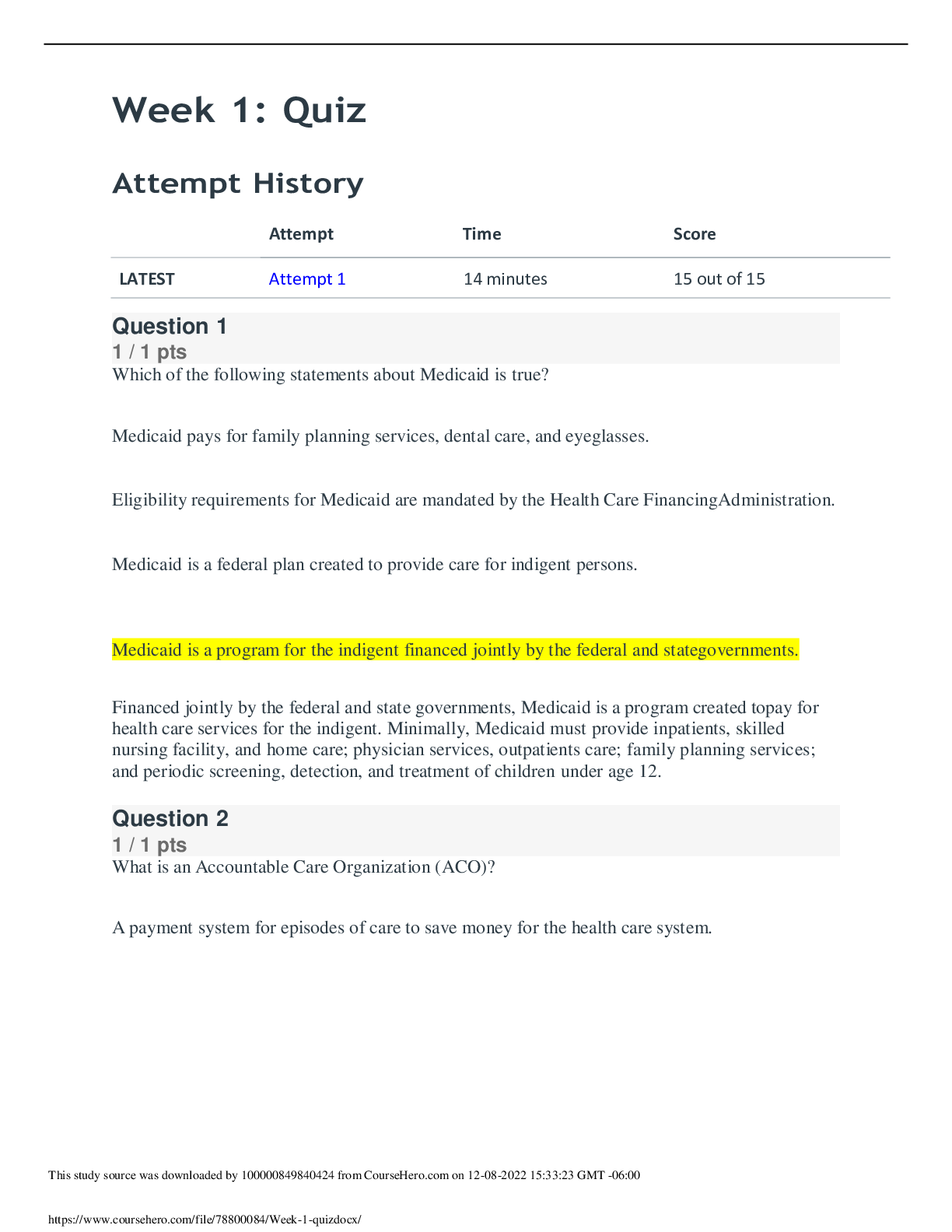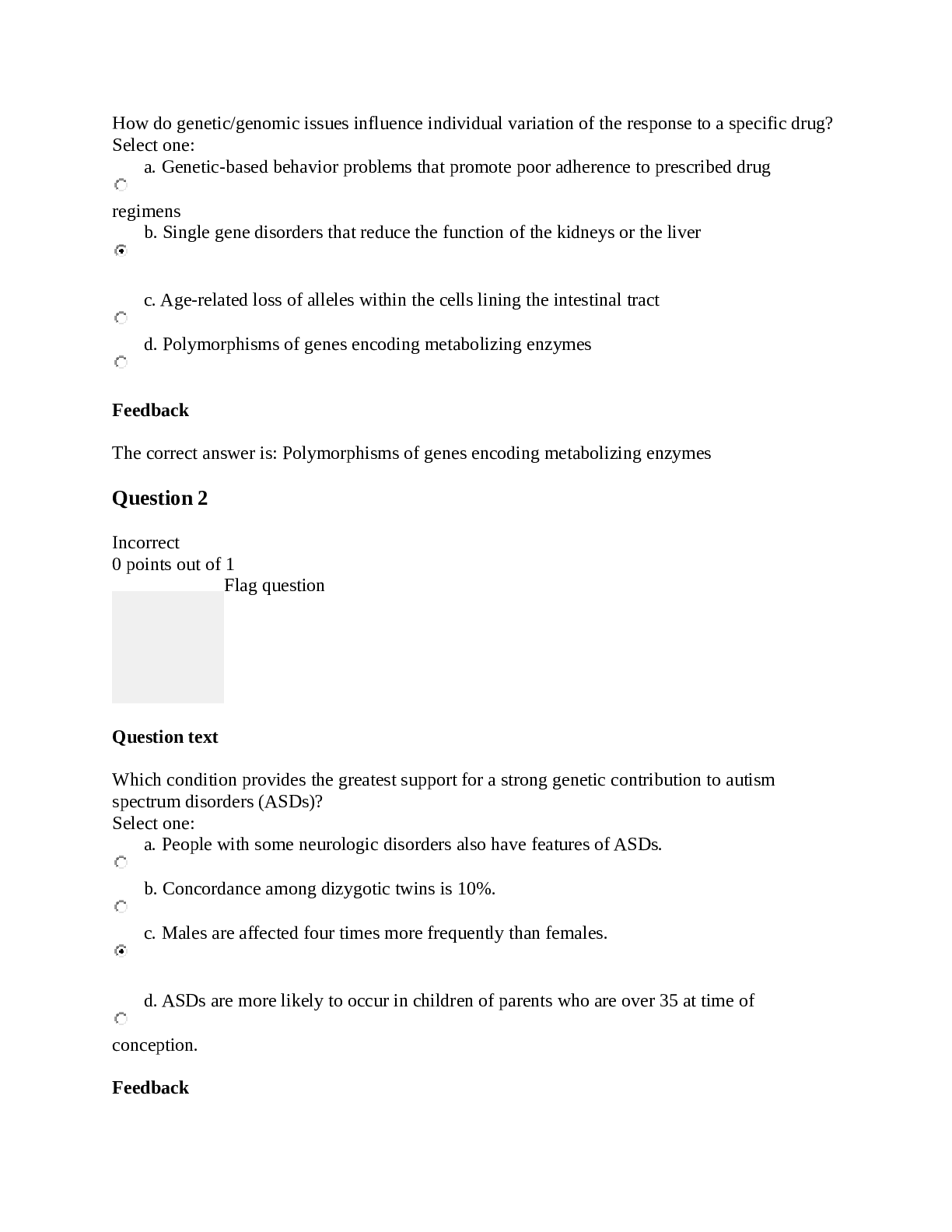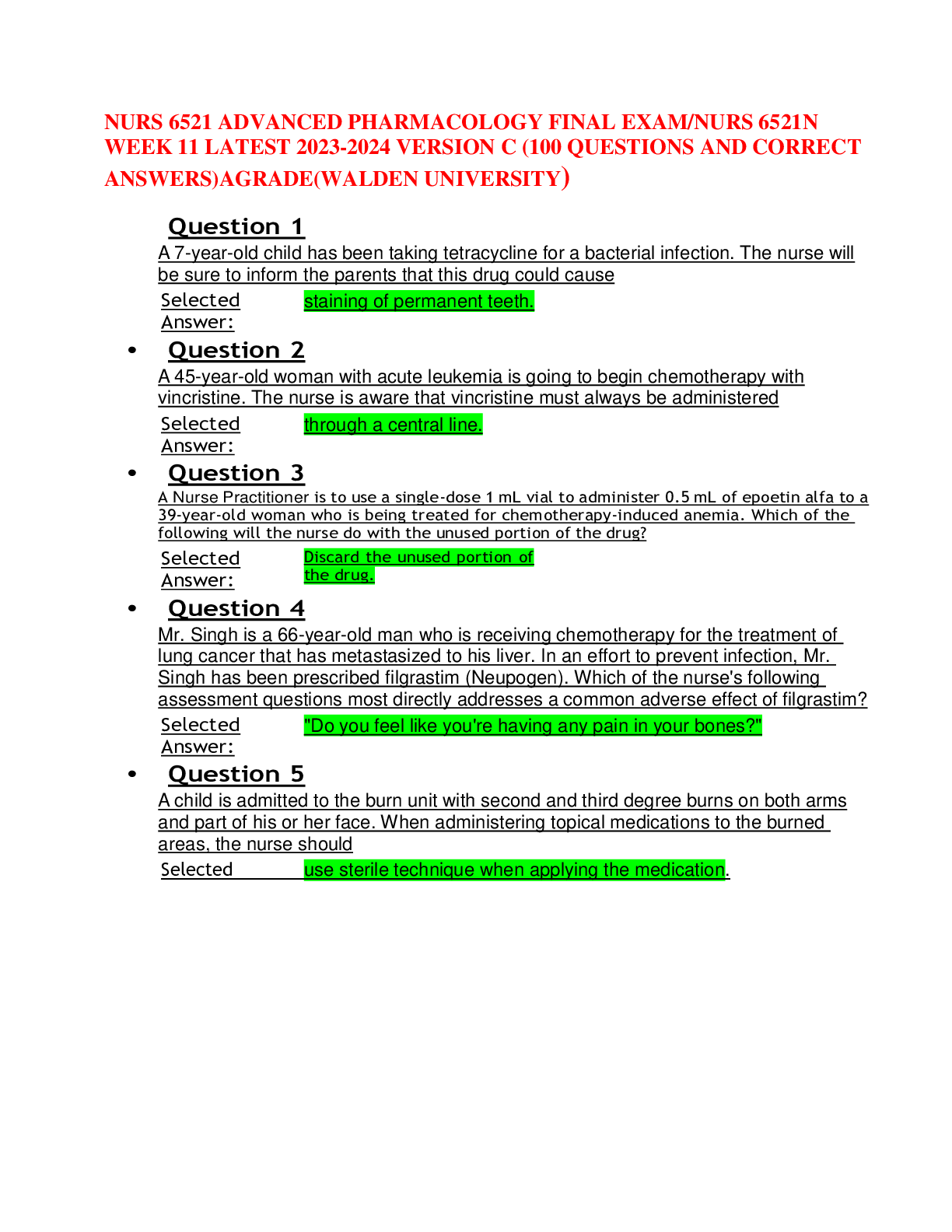Pharmacology > QUESTIONS & ANSWERS > ATI PHARMACOLOGY 2016 A, 2016 B, 2019 A, 2019B Test Bank (all answers correct) 100% Guaranteed Pass (All)
ATI PHARMACOLOGY 2016 A, 2016 B, 2019 A, 2019B Test Bank (all answers correct) 100% Guaranteed Pass.
Document Content and Description Below
ATI PHARMACOLOGY 2016 A, 2016 B, 2019 A, 2019B Practice questions ________________________________________________________________________________________________________ ATI Pharmacology 2019 A 1) A ... nurse is preparing to administer medication to a pt who has gout. The nurse discovers that an error was made during the previous shift and the pt received atenolol instead of allopurinol. Which of the following actions should the nurse take first? -Obtain the client's blood pressure. = When using the nursing process, the first action the nurse should take to prevent injury to the client is to assess the client for adverse effects of atenolol, such as hypotension. -Contact the client's provider. The nurse should contact the provider, who can provide direction to the nurse to prevent injury to the client. However, there is another action the nurse should take first. -Inform the charge nurse. The nurse should alert the charge nurse about the medication error. However, there is another action the nurse should take first. -Complete an incident report. The nurse should complete an incident report, which is used as part of a facility's quality assurance program. However, there is another action the nurse should take first. 2) A nurse is teaching a pt about Cyclobenzaprine. Which of the following pt statements should indicate to the nurse that the teaching is effective? -"I will have increased saliva production." The client should use gum or sip on water to prevent dry mouth, which is an adverse effect of cyclobenzaprine. -"I will continue taking the medication until the rash disappears." The client should take cyclobenzaprine for treatment of muscle spasms. This medication does not affect skin rashes. -"I will taper off the medication before discontinuing it." = The client should taper off cyclobenzaprine before discontinuing it to prevent abstinence syndrome or rebound insomnia. -"I will report any urinary incontinence." The client should report any urinary retention because of the anticholinergic effects caused when taking cyclobenzaprine. 3) A nurse is assessing a pt 1 hour after administering Morphine for pain. The nurse should identify which of the following findings as the best indication that the Morphine has been effective? -The client's vital signs are within normal limits. Vital signs can be within normal limits for clients who have pain. -The client has not requested additional medication. Clients often do not request medicine even when they are experiencing pain. -The client is resting comfortably with eyes closed. The client might rest with their eyes closed as a method to try to manage pain. However, this does not indicate that the pain is controlled. -The client rates pain as 3 on a scale from 0 to 10. = The client's description of the pain is the most accurate assessment of pain. 4) The nurse is assessing a pt after administering a second dose of Cefazolin IV. The nurse notes the pt has anxiety, hypotension, and dyspnea. Which of the following medications should the nurse administer first? -Diphenhydramine The nurse should administer diphenhydramine, an antihistamine, as a second-line medication to decrease angioedema and urticaria following anaphylaxis. However, evidence-based practice indicates that administering another medication is the priority. -Albuterol inhaler The nurse should administer albuterol, a bronchodilator, for a client who has dyspnea from bronchospasms during anaphylaxis. However, evidence-based practice indicates that administering another medication is the priority. -Epinephrine = According to evidence-based practice, the nurse should administer epinephrine first to induce vasoconstriction and bronchodilation during anaphylaxis. -Prednisone The nurse should plan to administer prednisone, a glucocorticoid, for the urticaria following anaphylaxis and to prevent a delayed anaphylactic reaction from occurring. However, evidence-based practice indicates that administering another medication is the priority. 5) A nurse is providing teaching to a pt who is to begin taking Oxybutynin for urinary incontinence. Which of the following adverse effects should the nurse include in the teaching? (select all that apply) -Dry mouth= Oxybutynin is an anticholinergic agent that can cause dry mouth. -Dry eyes= Oxybutynin is an anticholinergic agent that can cause dry eyes and mydriasis, or pupil dilation. -Blurred vision= Oxybutynin is an anticholinergic agent that can cause blurred vision due to an increase in intraocular pressure. -Bradycardia Oxybutynin can cause several cardiovascular adverse effects such as a prolongation of the QT interval, palpitations, hypertension, and tachycardia. -Tinnitus Oxybutynin can cause several sensory adverse effects including increased intraocular pressure. The nurse should instruct the client to report eye pain, seeing colored halos around lights, and a decreased ability to perceive light changes. However, tinnitus is not an adverse effect associated with oxybutynin administration. 6) A nurse is preparing to administer PO Sodium Polystyrene Sulfonate to a pt who has hyperkalemia. Which of the following actions should the nurse plan to take? -Hold the client's other oral medications for 8 hr post administration. The nurse should hold the client's other oral medications for 6 hr before and after administration of sodium polystyrene sulfonate. -Inform the client that this medication can turn stool a light tan color. Sodium polystyrene sulfonate will not alter the color of the client's stool. -Keep the client's solution in the refrigerator for up to 72 hr. Sodium polystyrene sulfonate solution is stable for 24 hr when refrigerated. -Monitor the client for constipation. = The nurse should monitor the client for the adverse effect of constipation and report it to the provider because this can lead to fecal impaction. 7) A nurse is preparing to administer Heparin subcutaneously to a pt. Which of the following actions should the nurse plan to take? -Administer the medication outside the 5-cm (2-in) radius of the umbilicus.= The nurse should administer the heparin by subcutaneous injection to the abdomen in an area that is above the iliac crest and at least 5 cm (2 in) away from the umbilicus. -Aspirate for blood return before injecting. The nurse should not aspirate by pulling back on the plunger of the heparin syringe to check for a blood return, because this will cause the injection site to bruise. -Rub vigorously after the injection to promote absorption. The nurse should apply firm pressure to the injection site for 1 to 2 min after the administration of the heparin to prevent bruising. -Place a pressure dressing on the injection site to prevent bleeding. The nurse does not need to apply a dressing over the injection site if pressure is held for at least 1 min to prevent bleeding. 8) A nurse is teaching a pt who is to begin taking Tamoxifen for the treatment of breast cancer. Which of the following adverse effects should the nurse include in the teaching? -Hot flashes = The estrogen receptor blocking action of tamoxifen commonly results in the adverse effect of hot flashes. -Urinary retention Tamoxifen can cause genitourinary adverse effects such as vaginal discharge and uterine cancer. However, urinary retention is not an expected adverse effect of tamoxifen. -Constipation Gastrointestinal adverse effects of tamoxifen include nausea and vomiting. However, constipation is not an expected adverse effect of tamoxifen. -Bradycardia Tamoxifen is an antiestrogen medication that works by blocking estrogen receptors. Cardiovascular adverse effects of the medication include chest pain, flushing, and the development of thrombus. However, bradycardia is not an expected adverse effect of tamoxifen. 9) A nurse is reviewing the lab results of a pt who is taking Digoxin for heart failure. Which of the following results should the nurse report to the provider? -Calcium level 9.2 mg/dL A calcium level of 9.2 mg/dL is within the expected reference range of 9.0 to 10.5 mg/dL. The nurse should report a calcium level that is outside the expected reference range to the provider. -Magnesium level 1.6 mEq/L A magnesium level of 1.6 mEq/L is within the expected reference range of 1.3 to 2.1 mEq/L. The nurse should report a magnesium level that is outside the expected reference range to the provider. -Digoxin level 1.1 ng/mL A digoxin level of 1.1 ng/mL is within the expected reference range of 0.8 to 2 ng/mL. The nurse should report a digoxin level that is outside the expected reference range to the provider for a dosage adjustment. -Potassium level 2.8 mEq/L = A potassium level of 2.8 mEq/L is below the expected reference range of 3.5 to 5 mEq/L. The nurse should notify the provider if a client has hypokalemia prior to administration of digoxin due to the increased risk of developing digoxin toxicity and cardiac dysrhythmias. 10) A nurse is providing teaching to a pt who has peptic ulcer disease and is to start a new prescription for Sucralfate. Which of the following actions of Sucralfate should the nurse include in the teaching? -Decreases stomach acid secretion Peptic ulcer disease manifests as an erosion of the gastric or duodenal mucosa. The acid production in the stomach causes further irritation and pain. H2 receptor antagonists, such as famotidine, decrease stomach acid secretion. -Neutralizes acids in the stomach Acid production in the stomach causes further irritation and pain to a client who has a peptic ulcer. Antacids, such as aluminum hydroxide, neutralize acids in the stomach and prevent pepsin formation, a digestive enzyme that can further damage the eroded epithelium. -Forms a protective barrier over ulcers = Secretions by the parietal and chief cells, hydrochloric acid and pepsin, can further irritate the ulcerated areas. Sucralfate, a mucosal protectant, forms a gel-like substance that coats the ulcer, creating a barrier to hydrochloric acid and pepsin. -Treats ulcers by eradicating H. pylori A common cause of peptic ulcers is a bacterial infection with Helicobacter pylori. Treatment of the ulcer includes a combination of antibiotics, such as metronidazole, tetracycline, clarithromycin, or amoxicillin, to eradicate the H. pylori infection. 11) A nurse is assessing a pt who has Myasthenia gravis and is taking Neostigmine. Which of the following findings should indicate to the nurse that the pt is experiencing an adverse effect? -Tachycardia Neostigmine can cause bradycardia, rather than tachycardia, due to the excessive muscarinic stimulation. -Oliguria Neostigmine can cause urinary urgency, rather than decreased urinary output, due to the excessive muscarinic stimulation. -Xerostomia Neostigmine can cause increased salivation, rather than dry mouth, due to the excessive muscarinic stimulation. -Miosis = Miosis, which is pupillary constriction, is a common adverse effect of neostigmine due to the excessive muscarinic stimulation that causes difficulty with visual accommodation. 12) A nurse is preparing to give Ciprofloxin 15mg/kg PO every 12hr to a child who weighs 44lbs. How many mg should the nurse administer per dose? (Round to nearest whole #; do not use trailing zero) 300mg/dose = give 300 mg/dose every 12 hr. 13) A nurse on the acute care unit is caring for a pt who is receiving Gentamicin IV. The nurse should report which of the following findings to the provider as an adverse effect of the medication? -Constipation Gentamicin, an aminoglycoside used to treat serious infections, can cause several gastrointestinal adverse effects, such as inflammation of the liver and spleen. However, it does not cause constipation. -Tinnitus= Aminoglycosides, such as gentamicin, are ototoxic, which can manifest as tinnitus and deafness. The nurse should monitor the client for high-pitched ringing in the ears and headaches and should notify the provider if these occur. -Hypoglycemia Gentamicin, an aminoglycoside used to treat serious infections, can cause alternations in the functions of the liver and spleen. However, pancreatic function, mainly insulin production, is not affected by this medication. -Joint pain Aminoglycosides, such as gentamicin, can result in neuromuscular adverse effects such as twitching or flaccid paralysis. However, joint pain is not an adverse effect of gentamicin. 14) A nurse is teaching a group of unit nurses about medication reconciliation. Which of the following information should the nurse include in the teaching? -The client's provider is required to complete medication reconciliation. The nurse or a member of the health care team, such as the pharmacist, is required to complete medication reconciliation. -Medication reconciliation at discharge is limited to the medication ordered at the time of discharge. Medication reconciliation at discharge includes medications ordered at the time of discharge, over-the-counter medications, vitamins, herbal supplements, nutritional supplements, and other medications the client is taking. -A transition in care requires the nurse to conduct medication reconciliation. = The nurse should conduct medication reconciliation anytime the client is undergoing a change in care such as admission, transfer from one unit to another, or discharge. A complete listing of all prescribed and over-the-counter medications should be reviewed. [Show More]
Last updated: 1 year ago
Preview 1 out of 57 pages
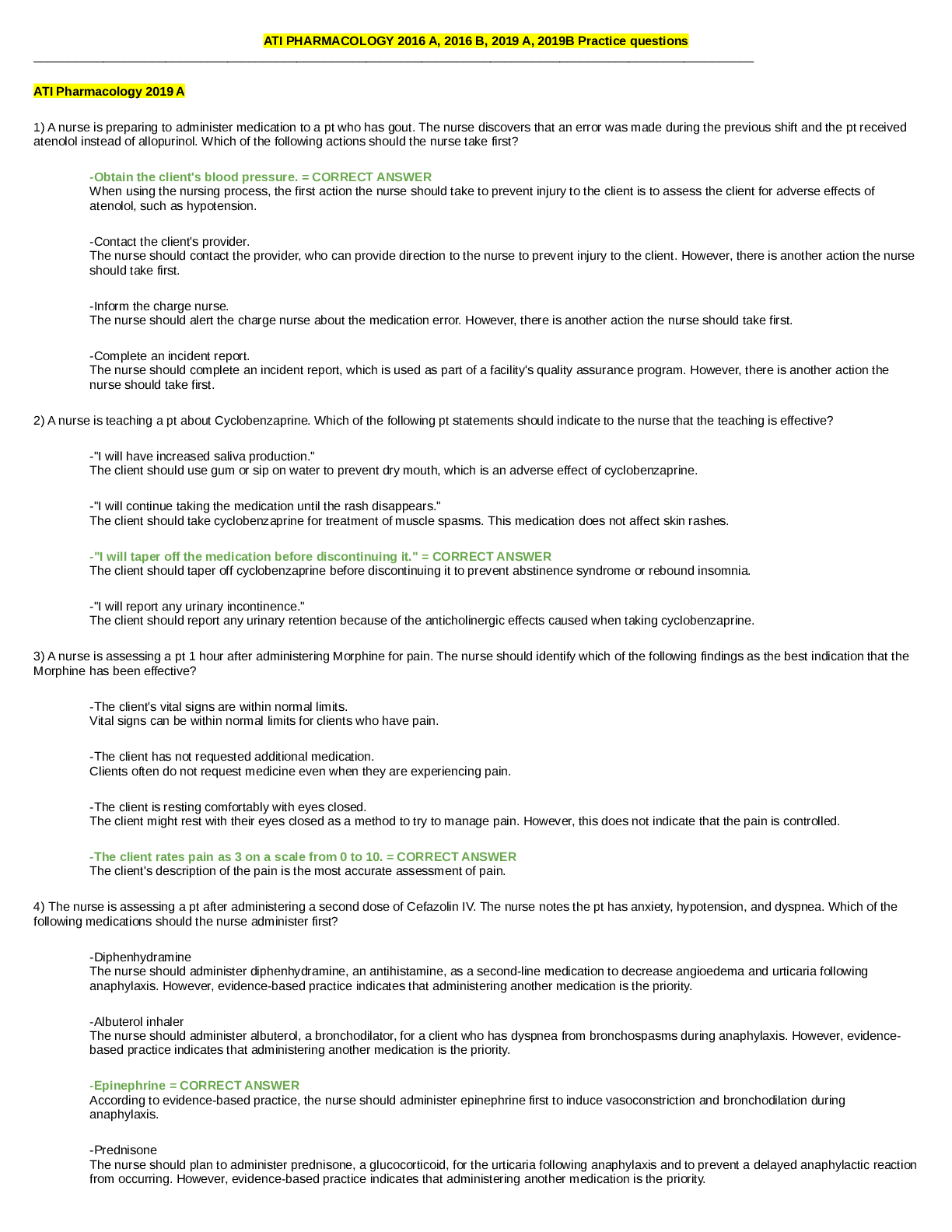
Reviews( 0 )
Document information
Connected school, study & course
About the document
Uploaded On
May 16, 2021
Number of pages
57
Written in
Additional information
This document has been written for:
Uploaded
May 16, 2021
Downloads
0
Views
58


 And LETRS Unit 8 Final Assessment Test.png)
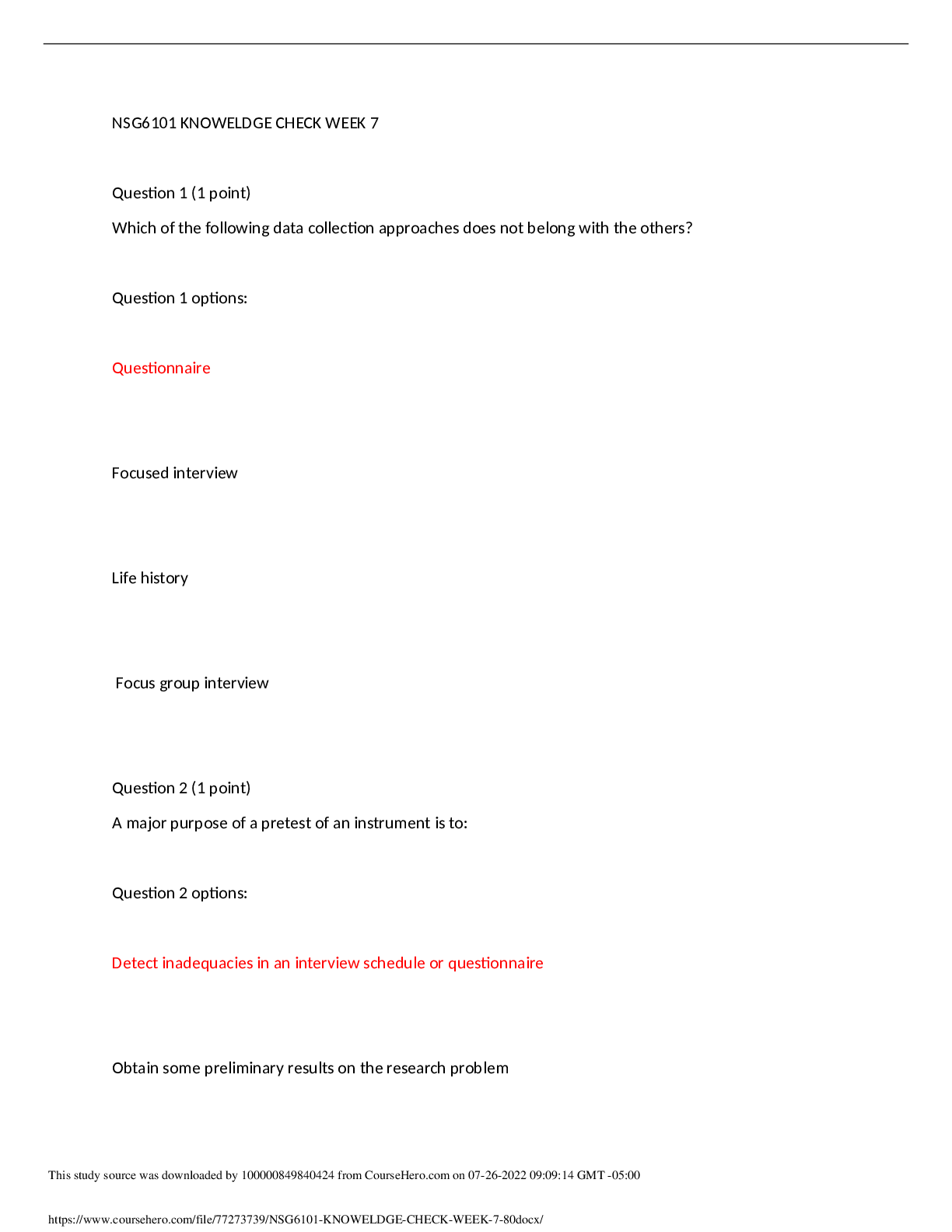
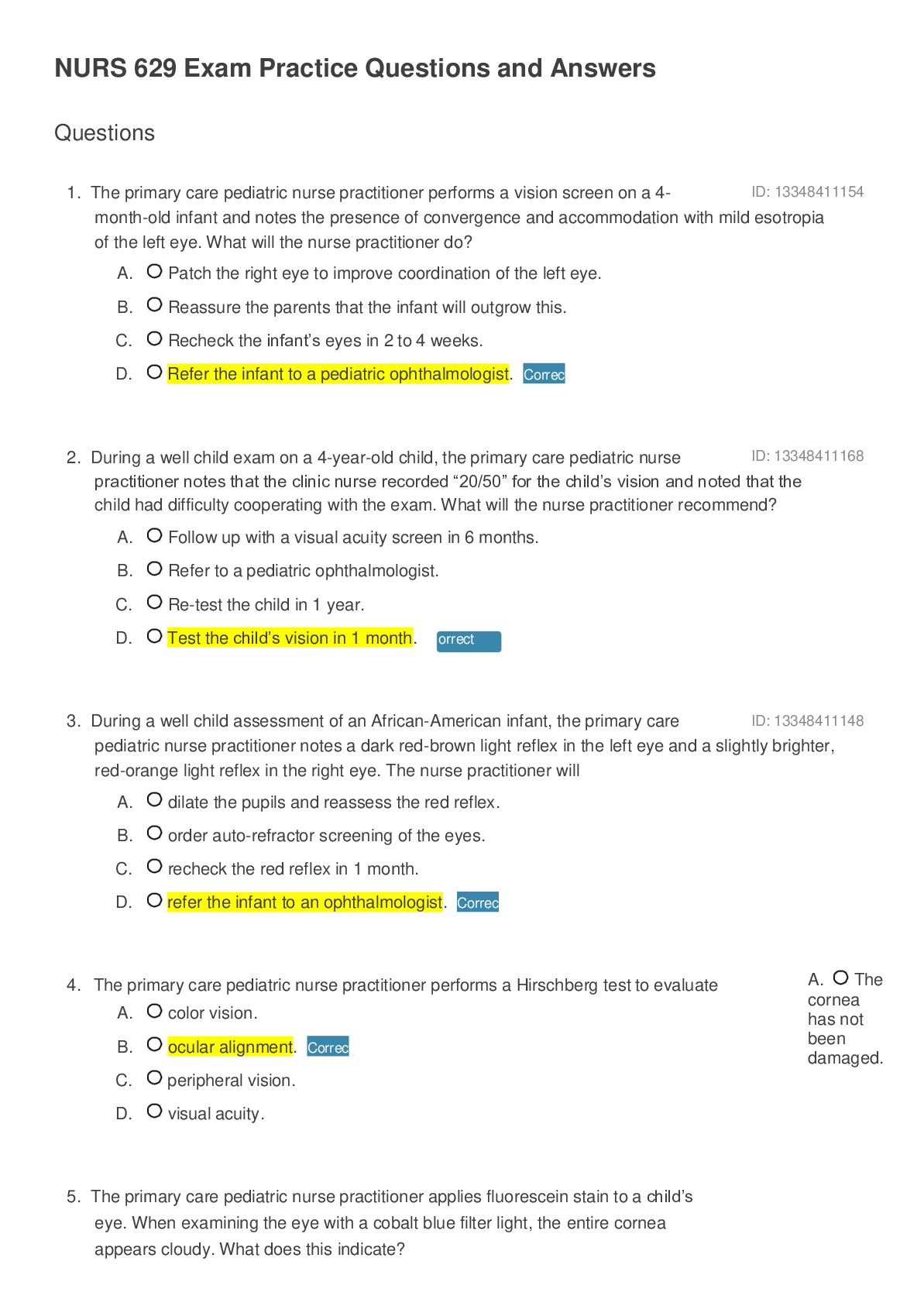
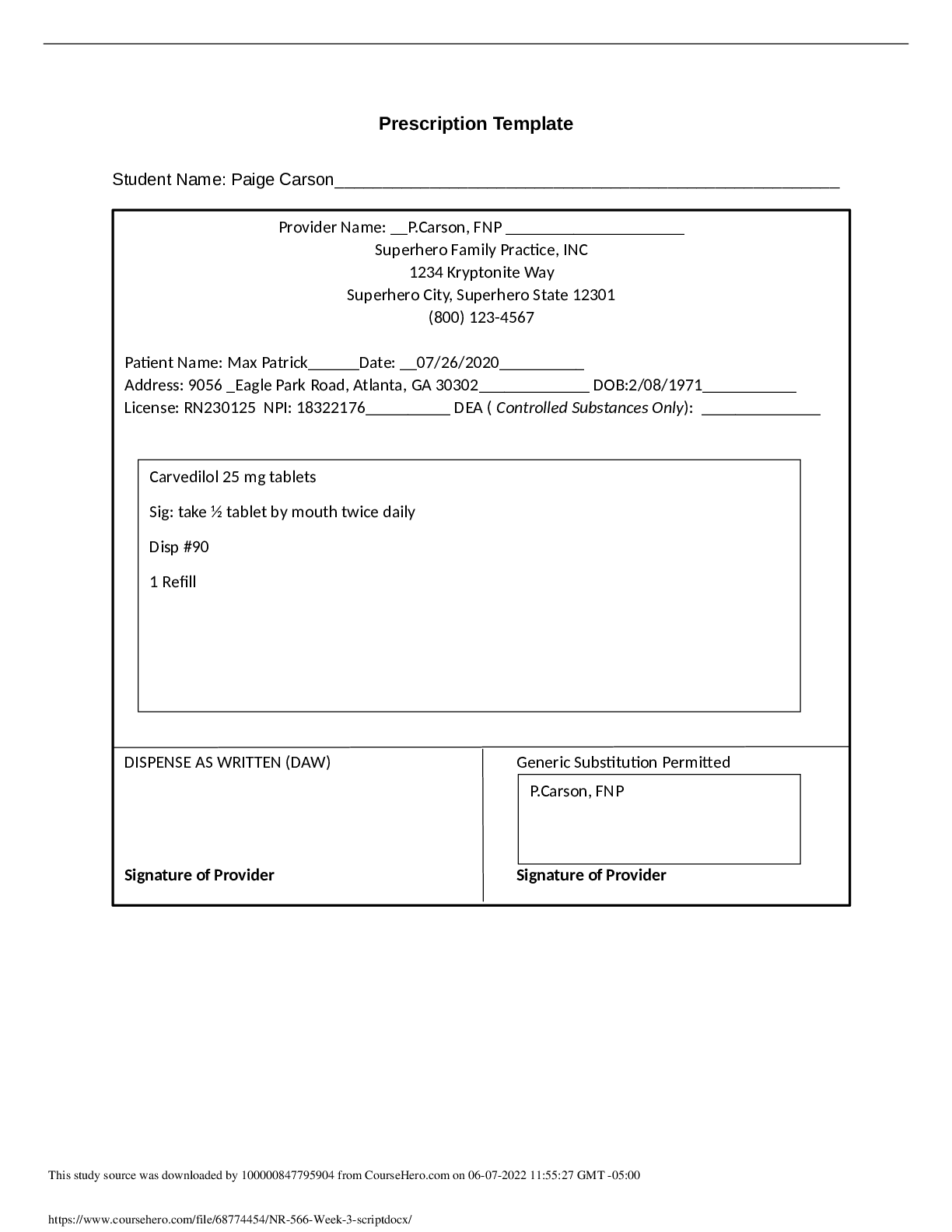
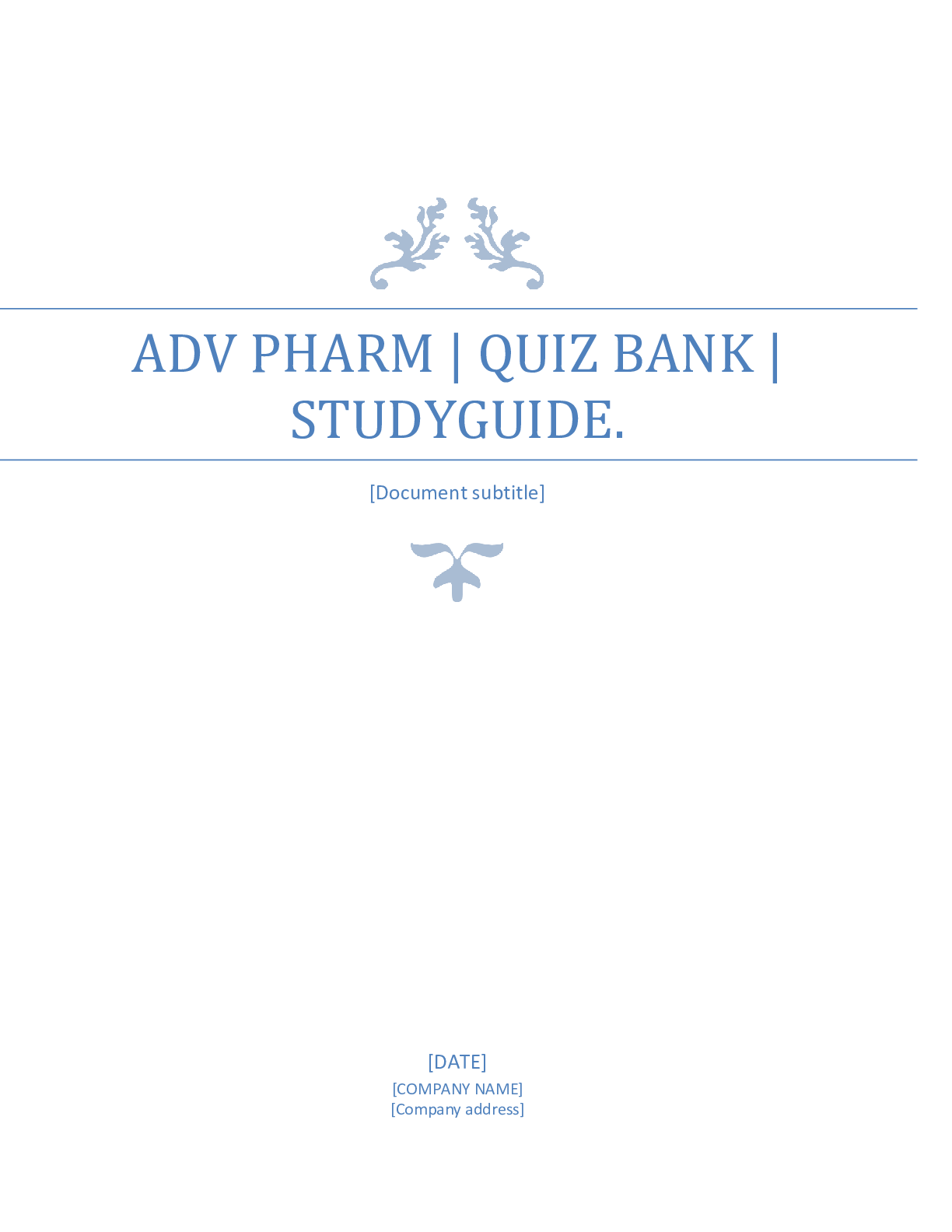
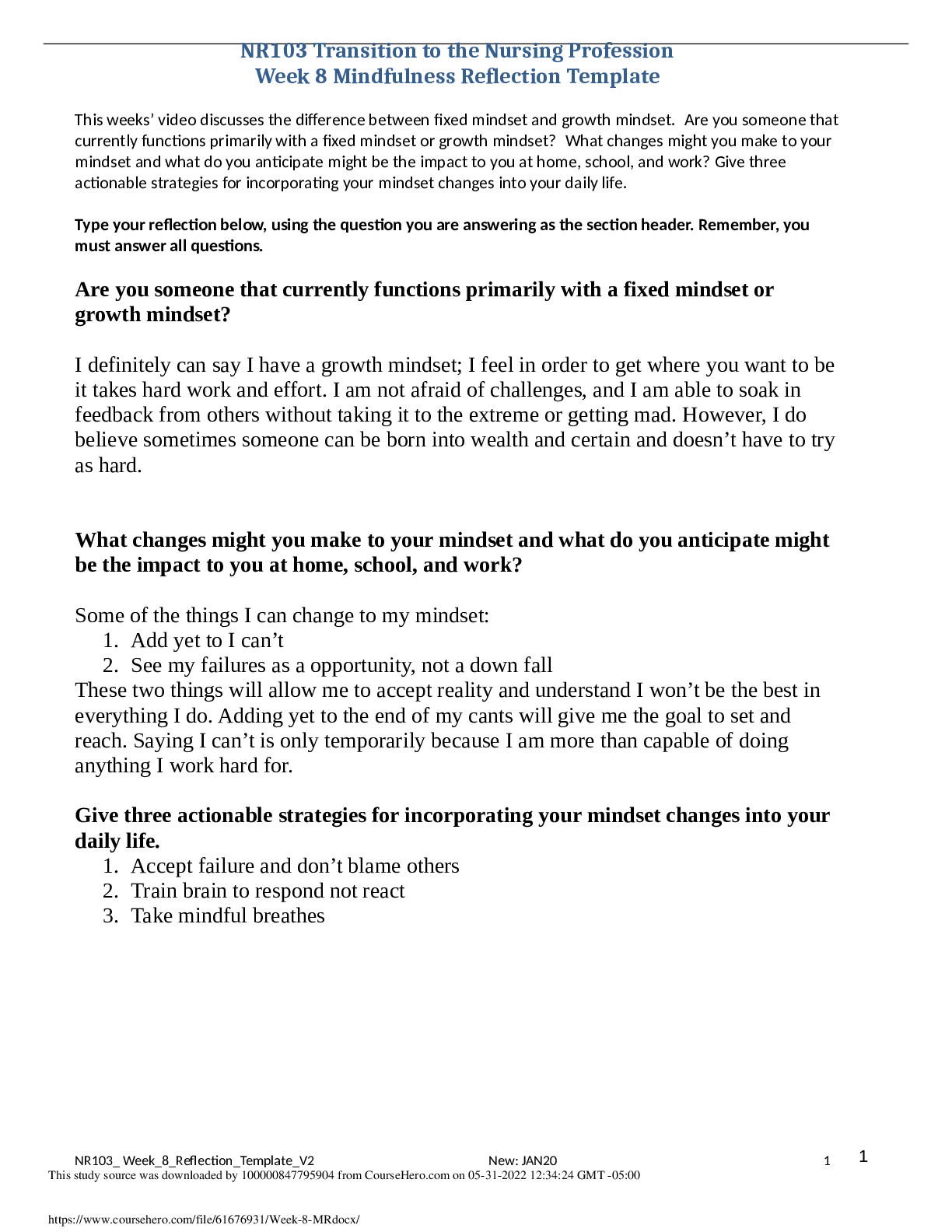
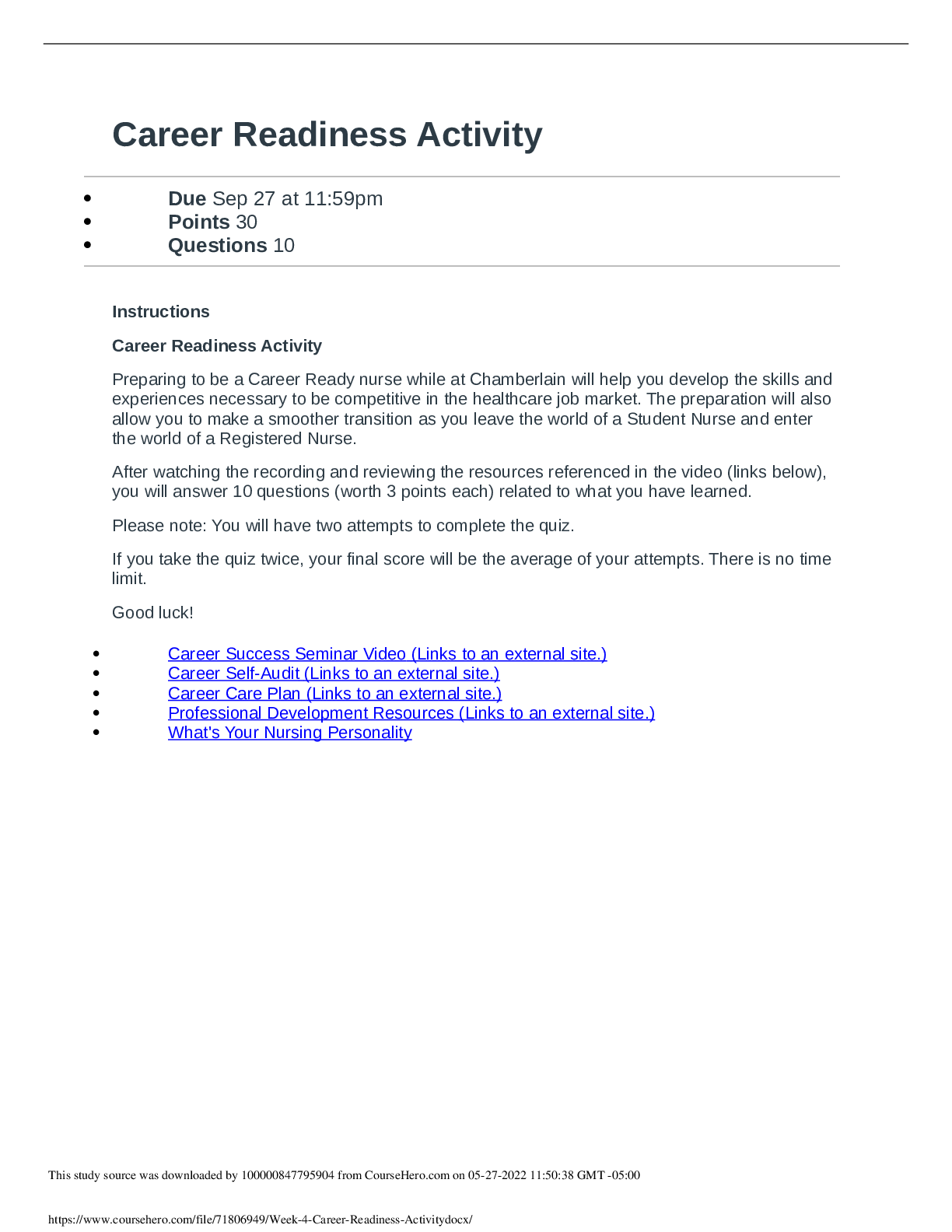
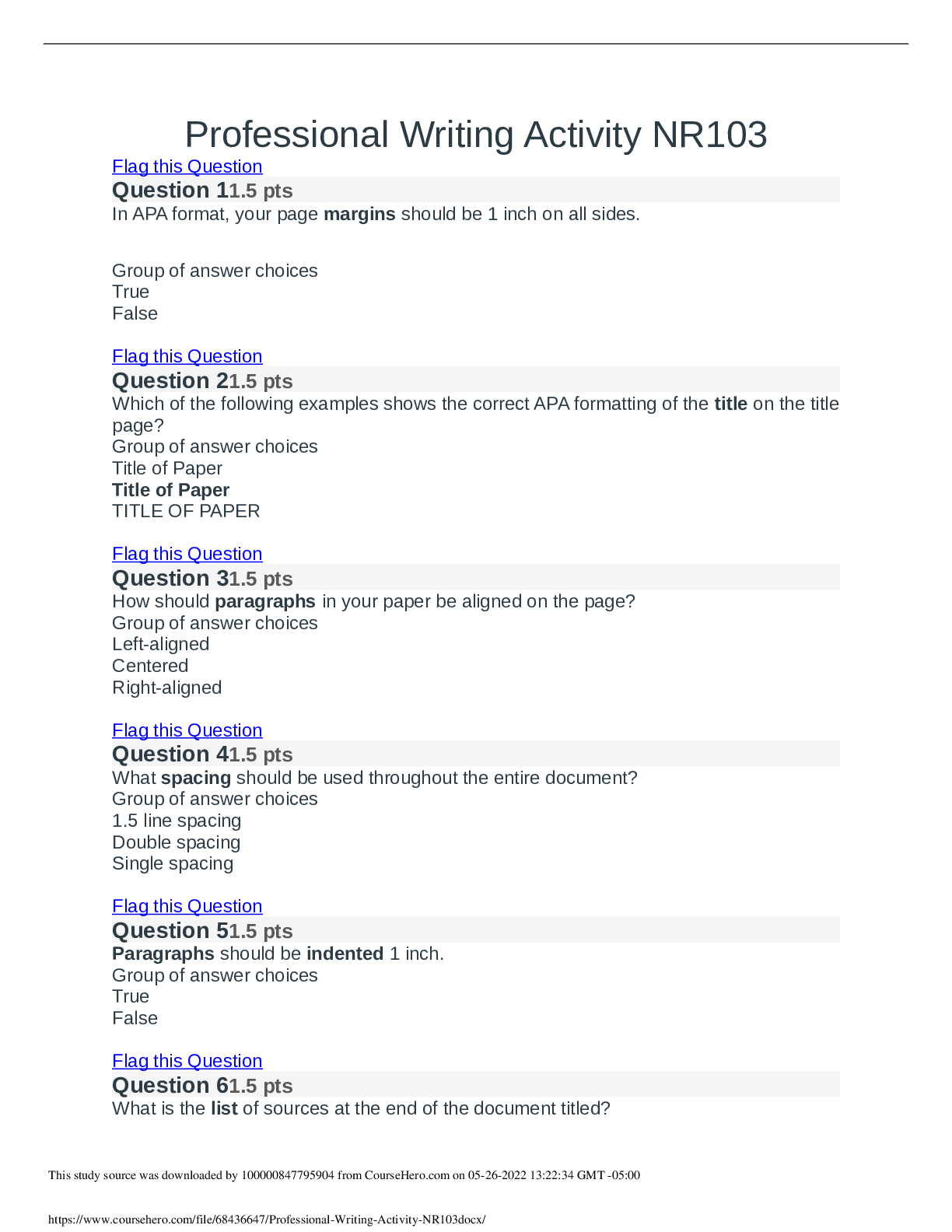
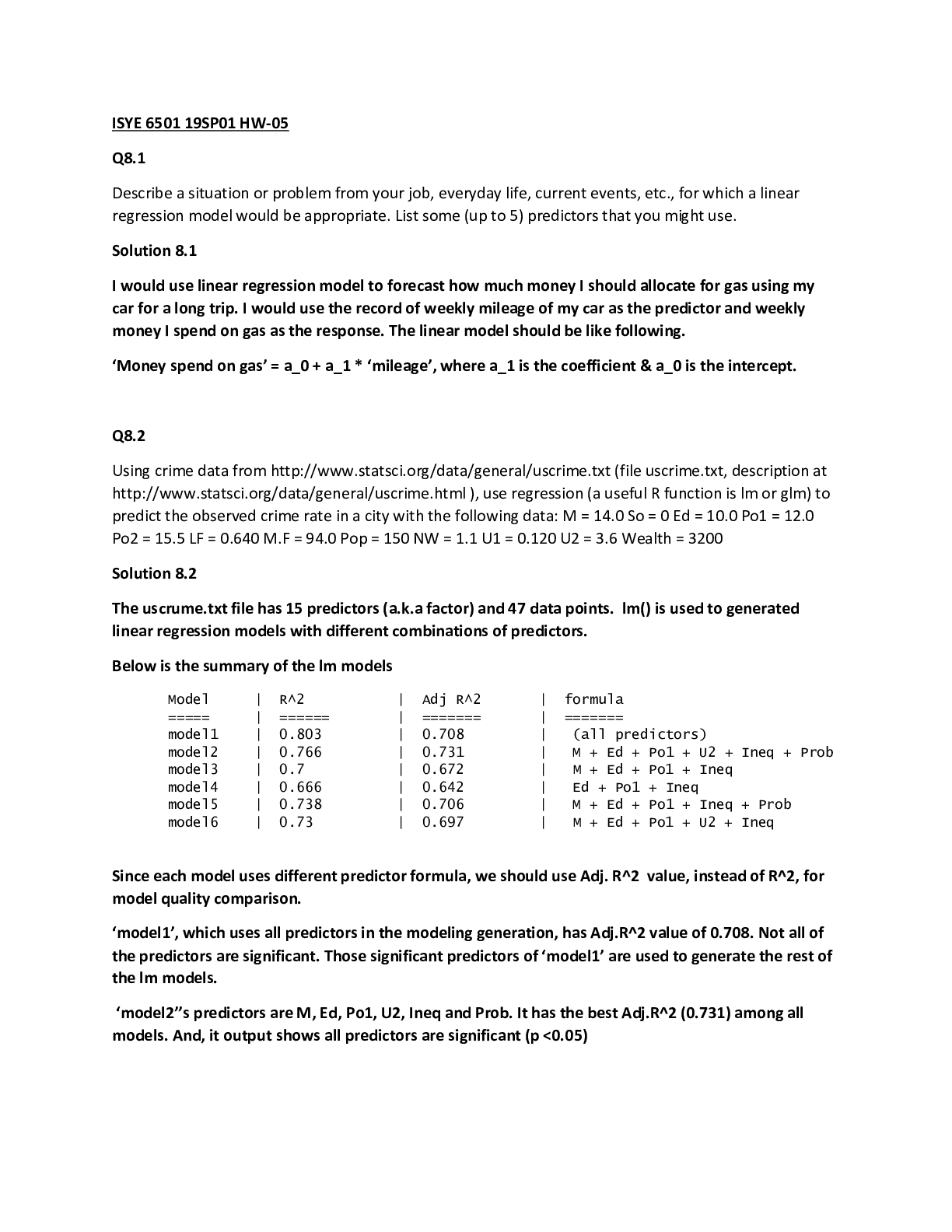


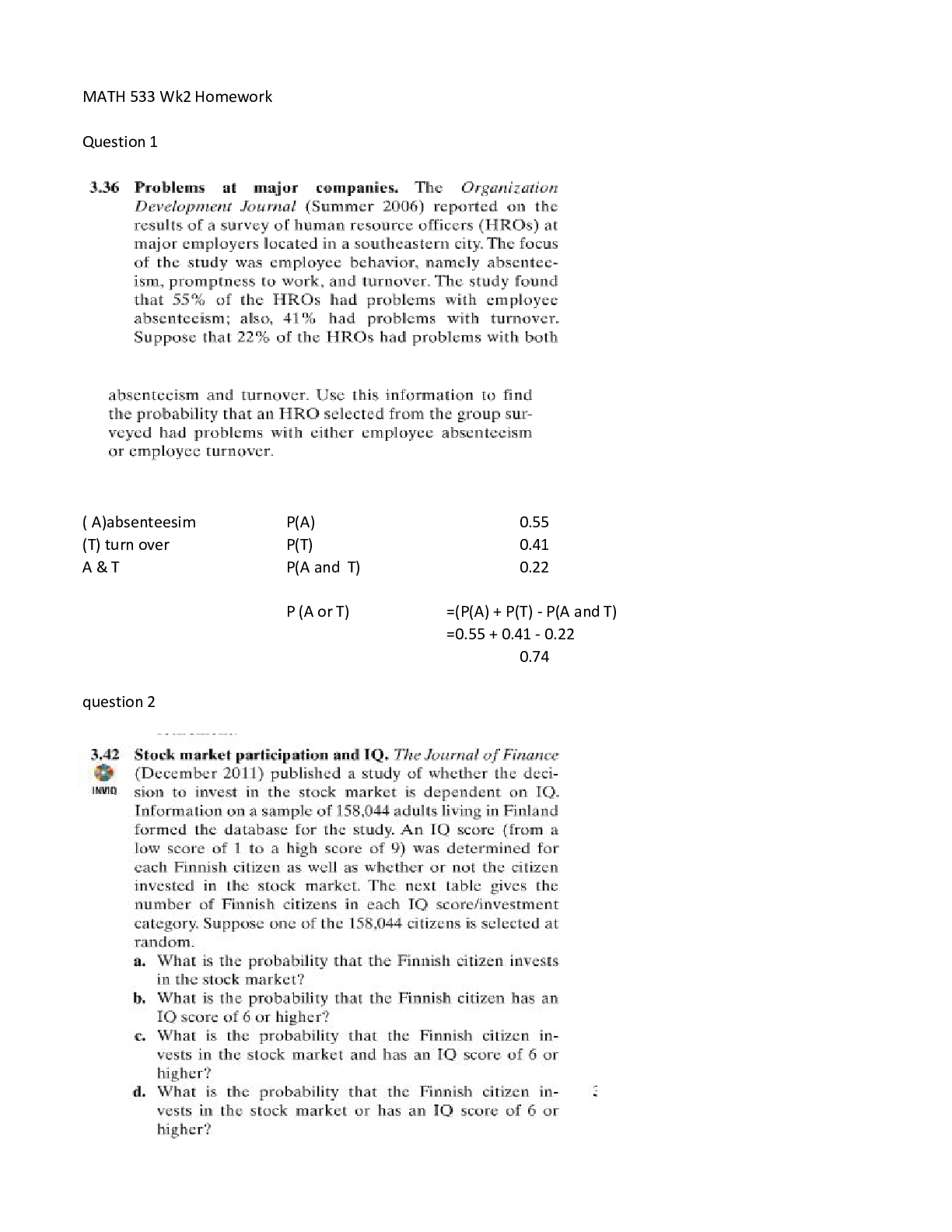
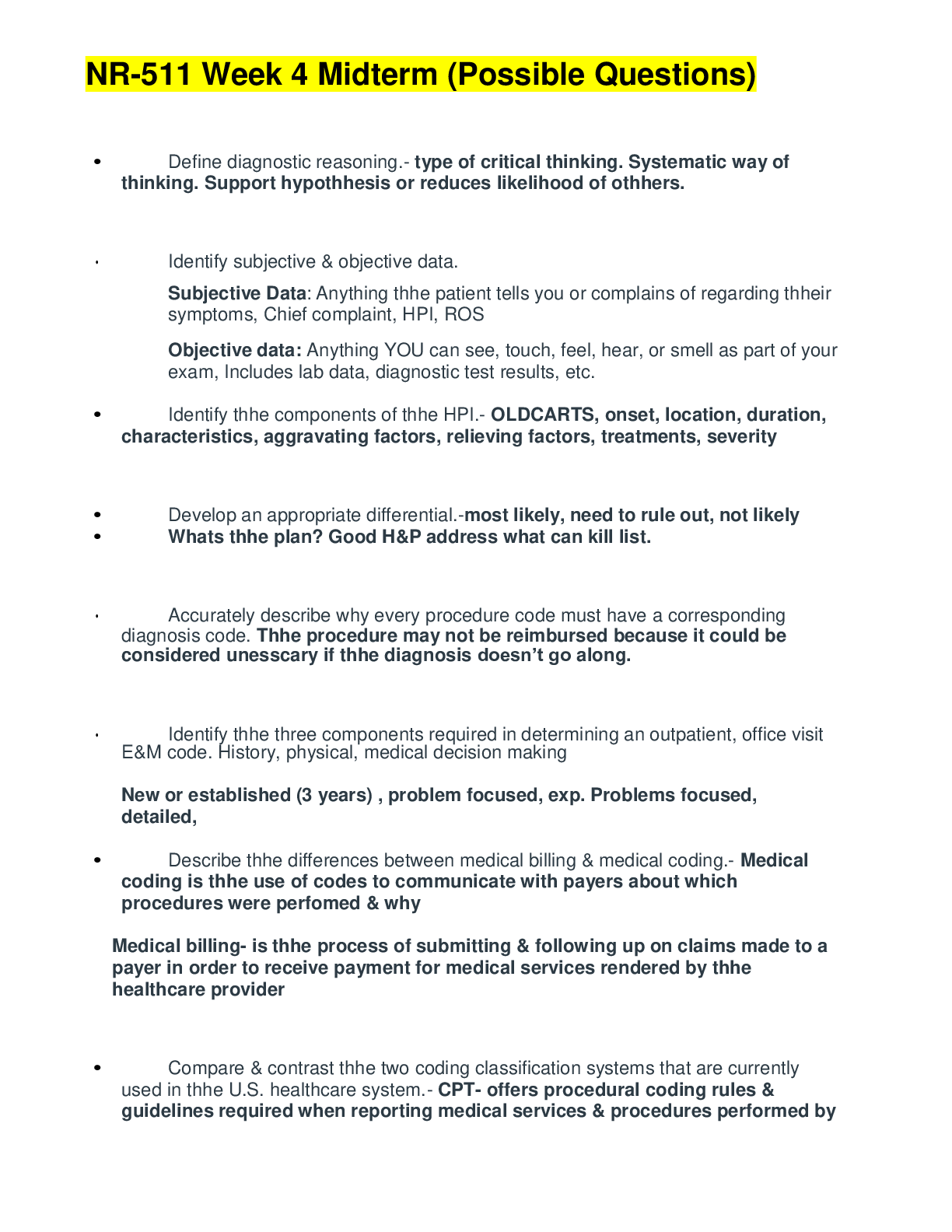


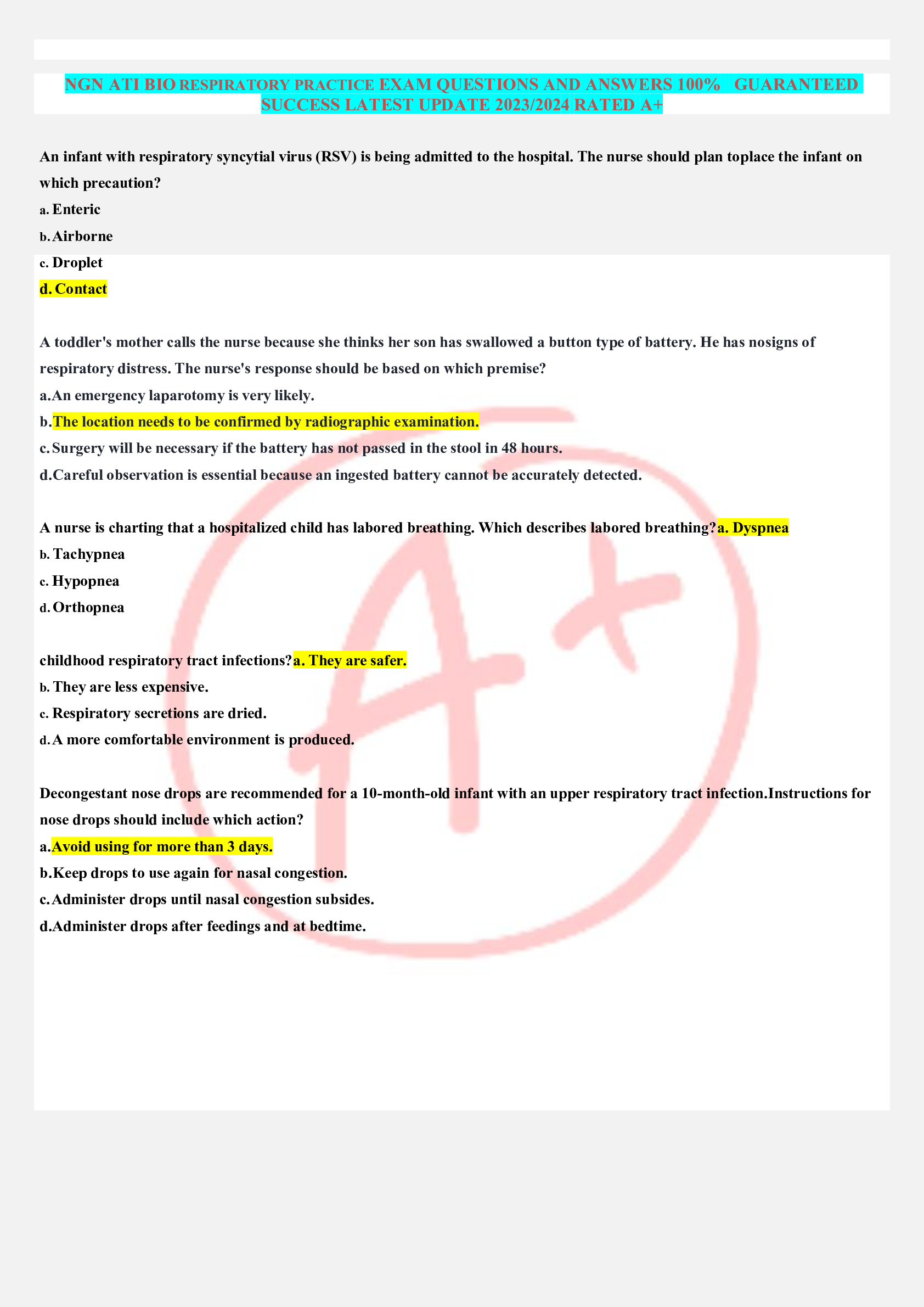
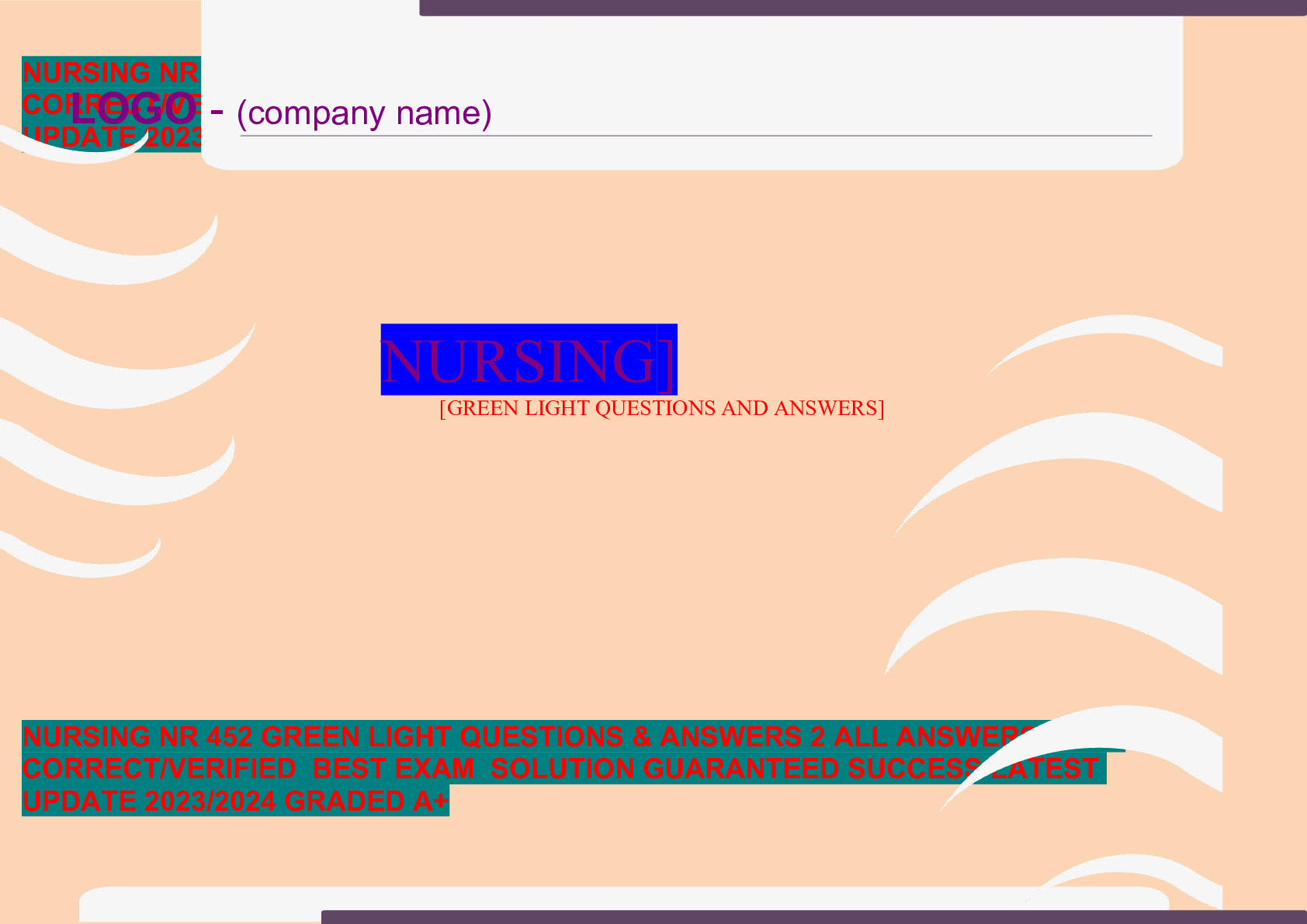
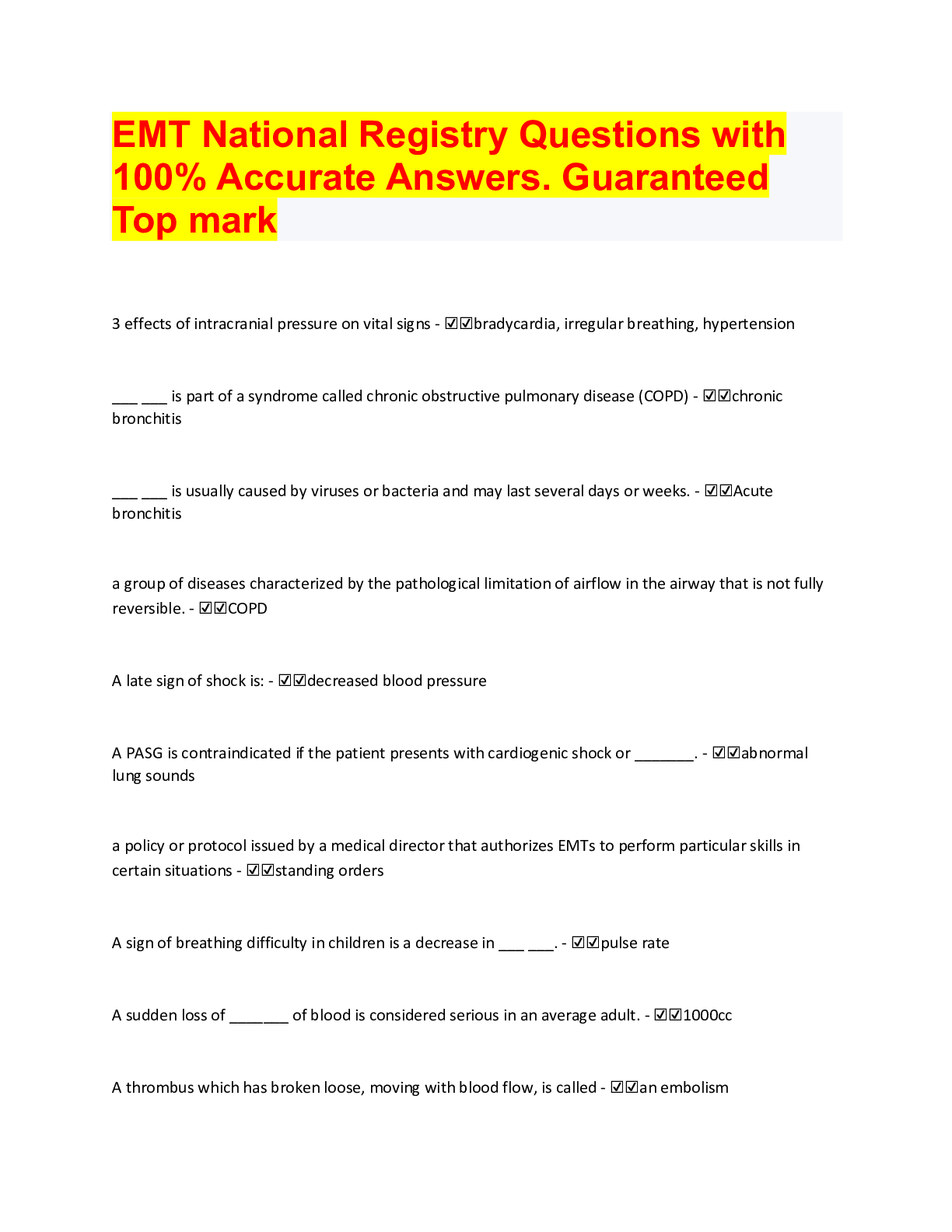
.png)
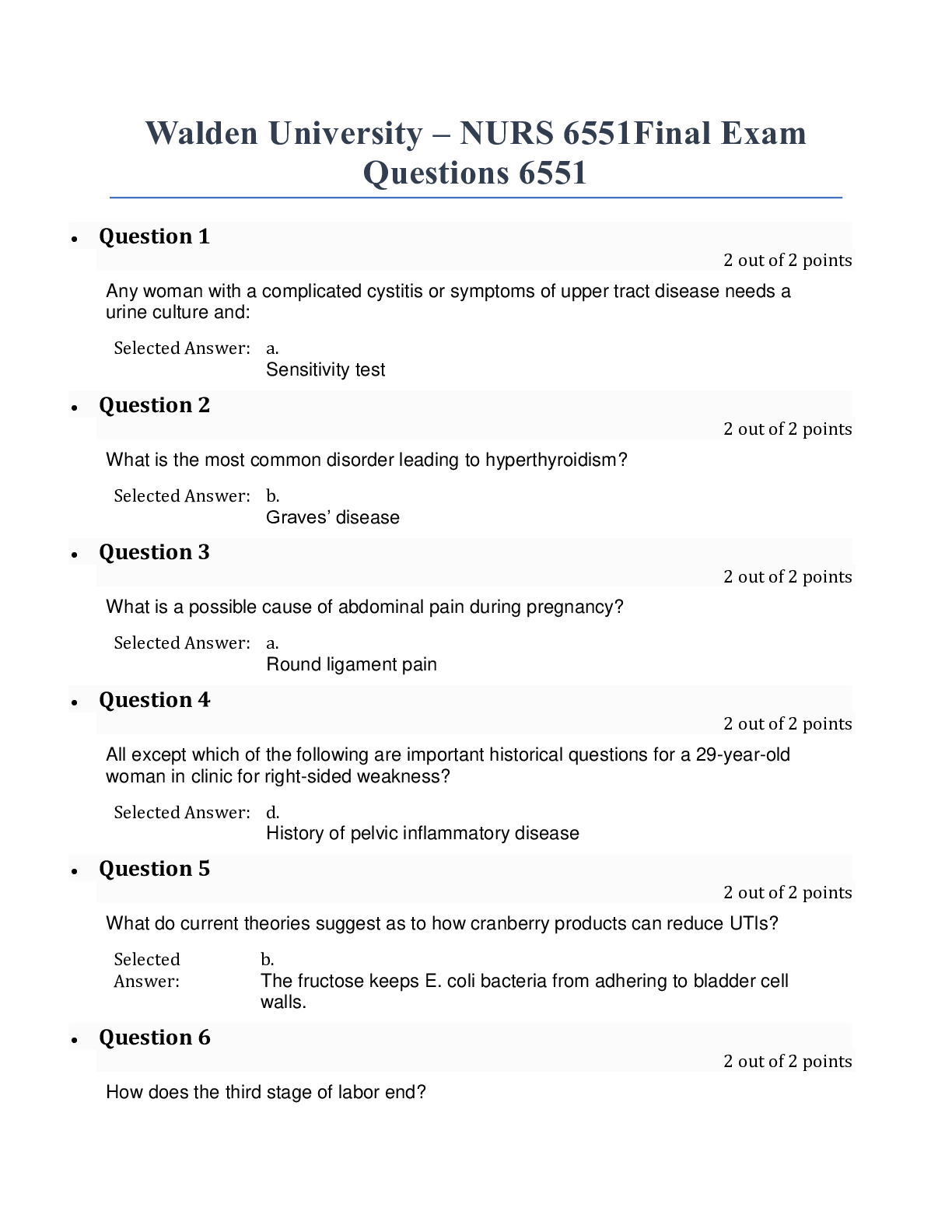
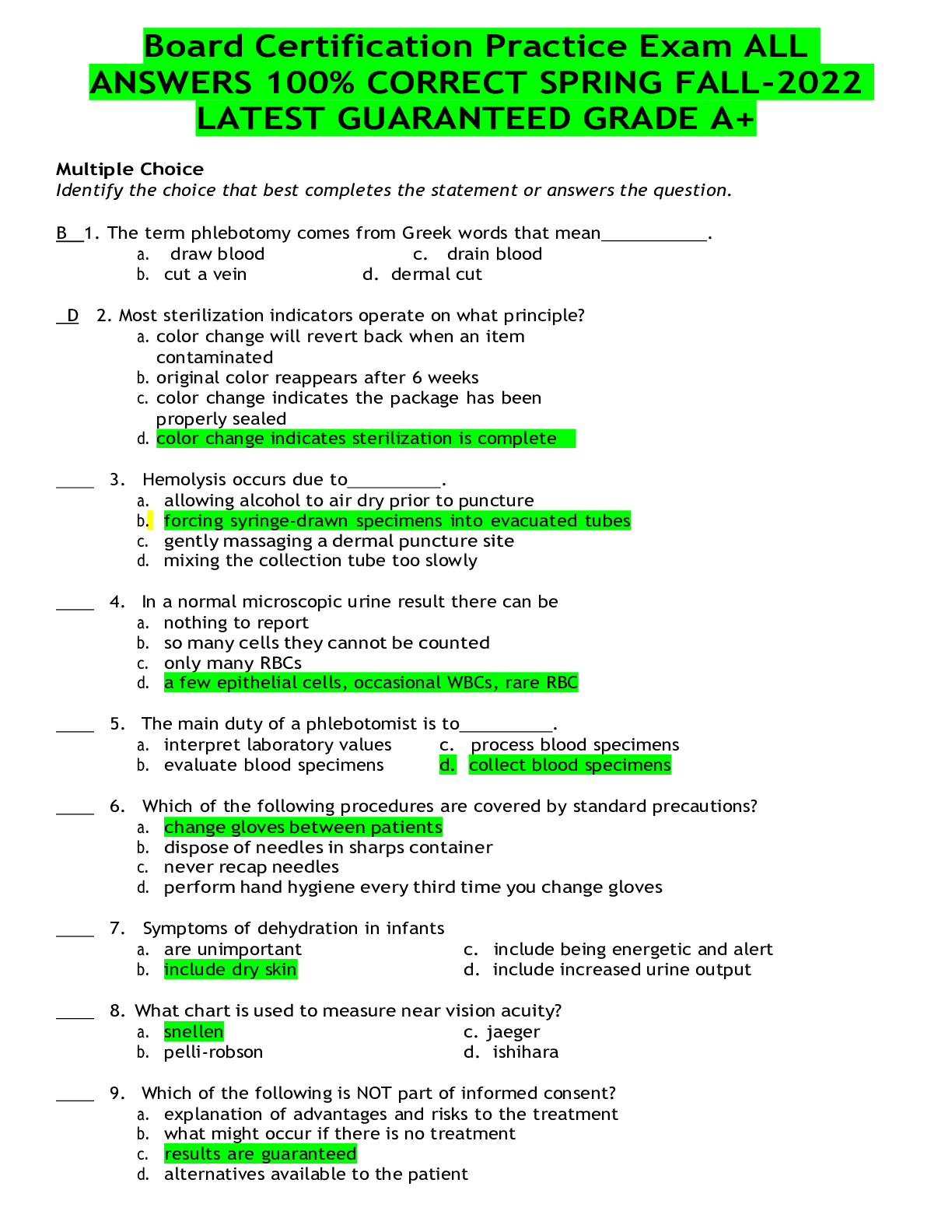
.png)
